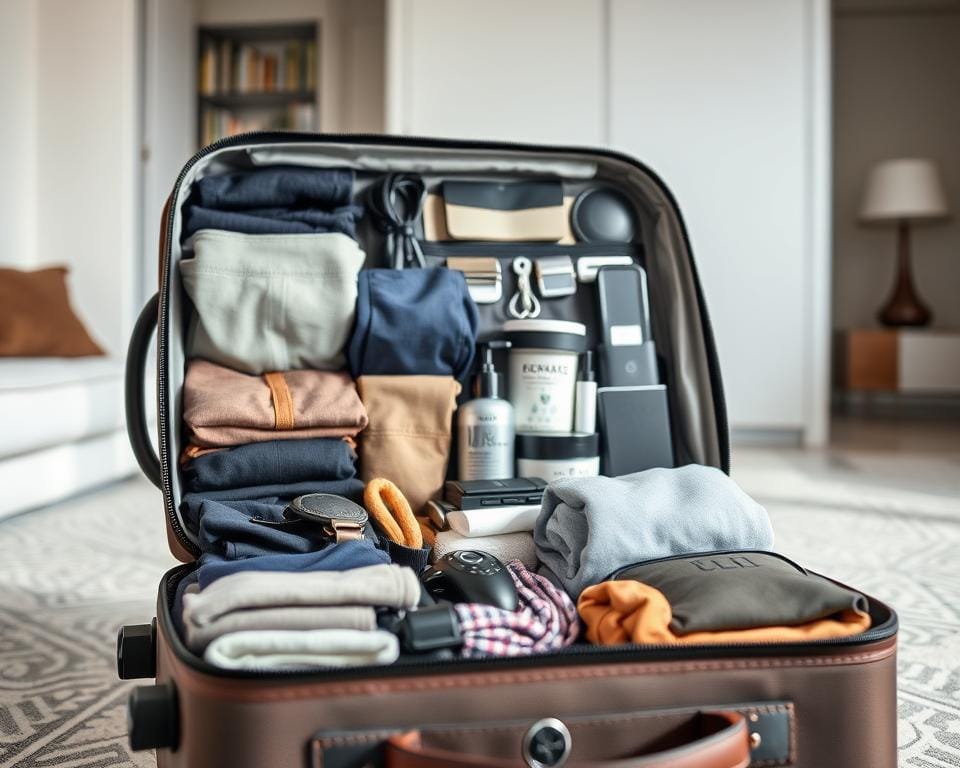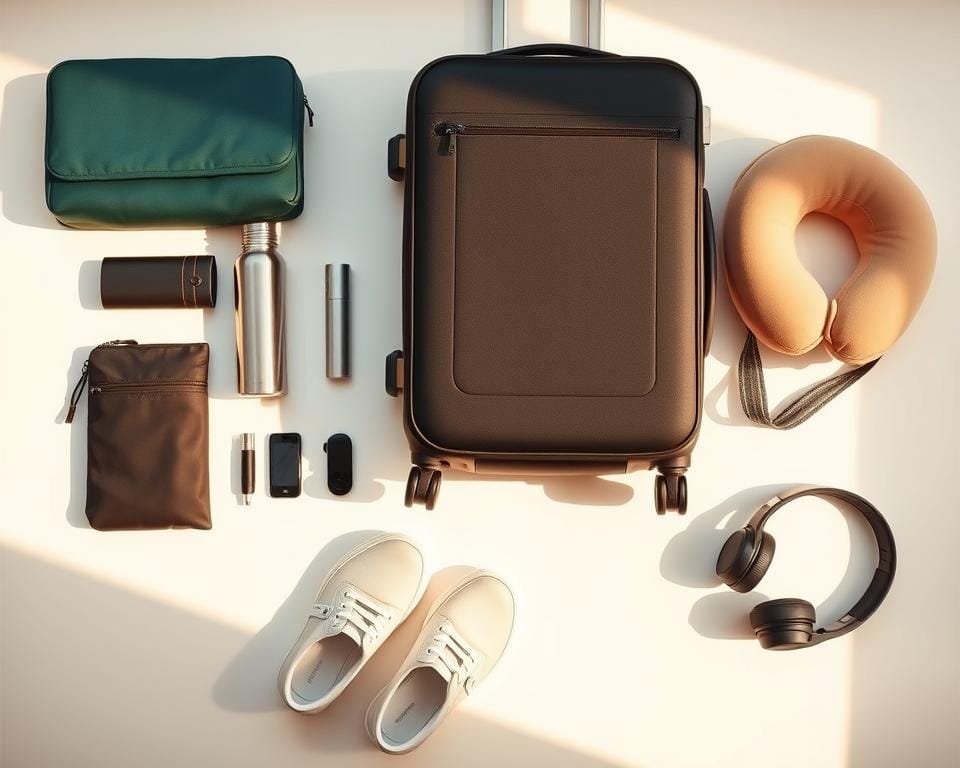What if you could skip airport queues, avoid lost bags, and keep your entire trip in one compact case? For years, I’ve navigated bustling cities, remote villages, and even a 12-day Spanish road trip using just cabin-sized luggage. My secret? A system that turns packing light into pure freedom.
Living with chronic pain taught me the value of simplicity. Hauling heavy suitcases became impossible, forcing me to rethink every item I packed. The payoff? Dodging a nightmare scenario in Stockholm when my 10-minute flight connection left checked bags stranded – while I sailed through with my trusty wheelie case.
This approach isn’t about deprivation. It’s about smarter choices that let you focus on experiences, not logistics. Imagine breezing past baggage carousels, hopping between destinations effortlessly, and knowing exactly where your toothbrush is. That’s the peace of mind I’ve discovered – and it’s transformed how I explore the world.
Key Takeaways
- Escape baggage fees and queues with cabin-sized packing strategies
- Maintain mobility during tight connections or transport changes
- Protect essentials from airline mishandling or delays
- Simplify packing routines for chronic pain sufferers
- Adapt your system for multi-climate trips
- Balance practicality with personal comfort items
Choosing the Right Cabin Luggage
Your case becomes your mobile wardrobe, tech hub and personal pharmacy – so getting this choice right matters more than you think. After testing 14 different models across 23 flights, I’ve found three non-negotiable features: airline-compliant dimensions, durable materials and smart organisation.
Size isn’t one-size-fits-all
Airline size limits vary wildly – Ryanair’s 40 x 20 x 25cm rules caught me out on a Dublin trip when my previous case was 2cm too deep. Now I swear by my Samsonite’s 45 x 36 x 20cm frame that works with EasyJet, BA and most European carriers. Check your regular airlines’ specs like this:
| Airline | Max Dimensions (cm) | Weight Limit |
|---|---|---|
| Ryanair | 40 x 20 x 25 | 10kg |
| EasyJet | 45 x 36 x 20 | Undisclosed |
| Emirates | 55 x 38 x 20 | 7kg |
| Virgin Atlantic | 56 x 36 x 23 | 10kg |
Durability beats Instagram appeal
My corporate-looking Samsonite has survived 4 years of rough handling – its polycarbonate shell shows barely a scratch. While the NORTVI recycled case looks sleeker, its lightweight build dented during a Madrid connection. For frequent flyers, scuff-resistant materials and reliable wheels prove worth the investment.
Consider under-seat options too – my 28L rucksack fits Ryanair’s personal item limits while holding 3 days’ essentials. The right bag becomes your travel companion, not just storage. Choose wisely and you’ll never glance at baggage carousels again.
Check Airline Baggage Allowances
Ever been caught out by hidden luggage charges? I learnt the hard way when a budget carrier demanded £50 for my supposedly compliant case. Now I treat airline policies like my pre-flight coffee – non-negotiable and thoroughly researched.
Basic fares often come with sneaky restrictions. Ryanair’s cheapest tickets only permit an under-seat bag, while EasyJet’s ‘upfront’ seat upgrade includes overhead locker access for less than checked baggage fees. Always compare prices – sometimes paying slightly more for your ticket saves money overall.
Three rules for stress-free packing
1. Check weight limits first: US carriers rarely enforce them, but Emirates once made me remove items at the gate to hit 7kg. 2. Study aircraft types – regional jets on short hops often have smaller lockers. 3. Book early for better carry-on bag allowances, especially with low-cost airlines.
My golden trick? Screenshot your airline’s specific rules when booking. Policies change constantly – that “standard” 10kg allowance might not apply to your particular route. A quick check prevents last-minute scrambles at the boarding gate.
Need help streamlining? My favourite week-long trip packing strategies work with even the strictest carry-on bag limits. Remember: knowledge about airlines’ quirks transforms packing from a chore into a superpower.
Pre-Trip Planning and Packing List
Smart travellers know the real packing magic happens before you open your case. My Bali blunder taught me this – I arrived with sundresses perfect for beaches, but froze during mountain temple visits. Now I start every trip with two crucial steps that eliminate guesswork.
Destination Detective Work
I spend 20 minutes researching three key factors for every trip. First, check weather forecasts for all locations – coastal Croatia’s 30°C days hid 10°C nights in the mountains. Second, note cultural requirements: light scarves for Thai temples, closed-toe shoes for Michelin-starred restaurants. Third, map activities – will you need hiking boots or ballet flats?
The Art of List-Making
Three days before departure, I draft my packing list while visualising each day. For a 5-day city break, I plan:
- 2 bottoms that mix with 3 tops
- 1 dress for fancy dinners
- Light layers for changing temps
This method helped me ditch “just in case” items. Last summer, I realised I could buy sunscreen in Spain rather than carry full bottles. Pro tip: stick your list on the fridge – add forgotten essentials as they pop into your head.
How to Travel With Only Hand Luggage
Discovering packing cubes revolutionised my trips more than any other travel hack. These fabric containers became my secret weapon during a chaotic Barcelona festival weekend, where quick outfit changes and messy hostel floors threatened to derail my zen. The right organisation system doesn’t just save space – it preserves sanity.

Essential tips for minimalist packing
Compression zips transform bulky jumpers into flat pancakes. I roll dresses around trouser legs to prevent creases, then squeeze them into my largest cube. Medium ones hold tops sorted by sleeve length, while the smallest keeps pants and bras tidy. Pyjamas live loose at the top – nobody wants to dig through layers at midnight.
Using packing cubes for organisation
My golden rule? Category-based packing beats random stuffing every time. Shoes become storage units for socks and hair ties. A lightweight laundry bag tucks beside the wheels, growing fuller as the trip progresses. When using cubes, I arrange them vertically like filing cabinet drawers – seeing everything at a glance beats rummaging.
This method survived a 10-day Scotland trip with merino layers and rain gear. The cubes’ structure prevented my case becoming a jumbled mess during daily hotel hops. Bonus? Unpacking takes two minutes flat – just transfer the cubes to drawers. Less time organising means more adventures.
Outfit Planning and Versatile Wardrobe
Creating a capsule wardrobe transformed my Spanish adventure from potential stress-fest to sartorial success. My secret? Treating every item like a puzzle piece that must connect with three others. Let me show you how 12 days’ worth of outfits fitted into a cabin bag without repeating looks.
Mix and match pieces for multiple occasions
My Spain arsenal revolved around a black-white-green colour scheme. Three dresses became six outfits with layering: the green sundress paired with a linen shirt for lunch, then solo for evenings. Wide-leg trousers worked with vest tops for city walks and t-shirts for beachside tapas.
This table shows how core pieces created endless combinations:
| Base Item | Day Look | Evening Twist |
|---|---|---|
| Black satin skirt | White trainers + graphic tee | Leather sandals + sequin vest |
| Striped dress | Denim jacket + sneakers | Gold jewellery + wedges |
| Cropped jeans | Oversized sweater + boots | Silk cami + heeled mules |
Shoes make or break a travel wardrobe. My black sandals dressed up dinner outfits, while white trainers handled cobbled streets. Both matched every bottom – no “third pair just in case” needed.
The real game-changer? That linen shirt moonlighting as a swimsuit cover-up, light jacket, and even an emergency pillow. Choosing multi-tasking clothes means carrying less while actually wearing more.
Optimising Carry-On Space

Mastering your carry-on’s capacity turns packing into a strategic game. I treat every centimetre like prime real estate – from the mesh pocket behind the pull handle to the hidden compartment under the wheels. Rolled clothes became my space-saving superpower during a sweaty Marrakech trip, letting me squeeze in two extra outfits versus folding.
This table shows why rolling beats traditional methods:
| Method | Space Used | Crease Risk |
|---|---|---|
| Rolling | 25% less | Low |
| Folding | Full | High |
| Compression | 40% less | Medium |
Wear your bulkiest items – I board flights in jeans and trainers regardless of destination weather. My bag’s main compartment holds lighter layers rolled tightly. Sandals live at the top for quick swaps when landing in tropical climates.
Don’t ignore shoe interiors! I stash socks and chargers inside trainers, using dust bags as extra storage. External pockets hold essentials like passports and lip balm – make sure you can grab them without opening the main case.
Strategic packing order saves time and space. Pyjamas go in last, while adaptors sit near the seat-front pocket for easy access. With this system, I’ve survived 10-day trips using standard carry-on bags without sacrificing comfort. Your luggage becomes a Tetris board – play it right and you’ll always win.
Packing Liquids and Toiletries
Navigating liquid restrictions became second nature after a Heathrow security officer confiscated my favourite moisturiser. Now I treat toiletries like precious cargo – strategically packed and ready for inspection. The key lies in smart decanting and understanding what counts as liquid (spoiler: it’s more than you think).
My Leak-Proof System
I use silicone bottles with colour-coded labels – blue for shampoo, green for toner. They survive altitude changes without exploding, unlike cheaper plastic ones. Three rules I swear by:
- Fill containers to 90ml to allow for expansion
- Wrap threads in cling film before screwing lids
- Store upright in clear zip-top bags
Solid Solutions Save Space
Shampoo bars from Lush transformed my routine – one 55g disc lasts 80 washes and fits in my non-liquid bag. I pair them with:
- Toothpaste tablets
- Deodorant creams in push-up tubes
- SPF sticks for face protection
At security checks, I keep my transparent bag in an outer pocket for quick access. For longer trips, I prioritise luxury products in my 10-container allowance and buy basics like shower gel locally. This approach saved me from a meltdown when Madrid’s airport scanners flagged a forgotten water bottle – everything else sailed through untouched.
Tech and Travel Accessories
The right tech accessories transformed my Edinburgh trip from chaotic to seamless. While scrambling for chargers during a layover, I realised gadgets need their own packing strategy. Now my cables, adaptors and power banks have designated homes – no more frantic rummaging through bags at security.
Keeping Gadgets Organised and Charged
My four-port travel adaptor became a game-changer in shared hostel rooms. It charges phone, e-reader, headphones and laptop simultaneously without hogging sockets. Colour-coded silicone bands keep cables tidy – pink for phone, blue for camera.
A slim power bank lives in my personal item during flights. The Nitecore 10,000mAh model passes airport checks while providing three full phone charges. For quick access, I use a clip-on pouch that attaches to my rucksack’s shoulder strap.
Cable management matters more than you’d think. Braided nylon cords survive rough handling better than flimsy plastic ones. My Anker wireless charger eliminates messy wires entirely – just drop my phone on the hotel nightstand.
Tech organisation isn’t about having the latest gear. It’s creating systems that let you focus on experiences, not dead batteries. With these essentials, I’ve navigated three countries in a week without once uttering “Where’s my charger?”

